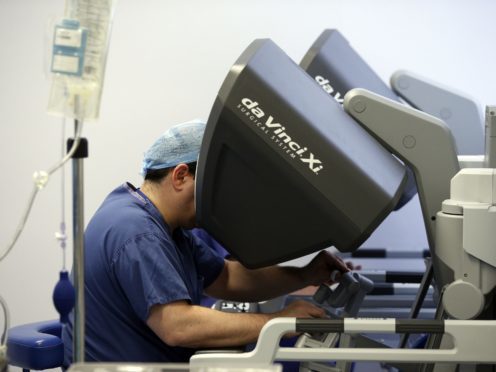A cancer patient is recovering at home after being operated on in two areas at the same time in a rare procedure using a robot.
Christine Lockton, from Croydon, south London, was diagnosed with colorectal cancer in September after she grew concerned about unexplained weight loss.
Tests revealed the 63-year-old had a large tumour in her bowel which was invading her womb.
After a course of radiotherapy and chemotherapy, in March she underwent a robotic hysterectomy and had part of her colon removed simultaneously, in a first for The Royal Marsden Hospital in London.
Ms Lockton, an NHS patient, was able to return home just days after the procedure, which offered a less invasive option to open surgery.
“I can’t believe how quickly I have been able to come out of hospital and it’s lovely to be home,” she said.
“I think the real healing will happen now.”
Surgeons sat on opposite sides of a robotic console as they performed the procedures. The technology enabled them to see the affected area in close detail using 3D magnified images.
The multidisciplinary approach – carrying out colorectal surgery and gynaecological surgery at the same time – while using robotics is a first for The Royal Marsden.
The “arms” of the robots allowed the team to make tiny movements and remove “all natural human tremor”, while its “hand” can rotate 360 degrees.
Surgeon Shahnawaz Rasheed, who led the operation with Marielle Nobbenhuis, said: “The precision of surgery, we think, is much higher.”
He added: “Because of that, the impact on the patient should be less.
“So we can do the same operation in terms of the removal of the cancer, but have less of a trauma to the patient.”
Ms Lockton thought she was suffering from a food allergy when she first developed symptoms in July last year.
“I had periodic attacks of something I thought was probably food-related and then in August, it got a bit worse,” she said.
“Towards the end of August, in a week, I lost four pounds and I couldn’t find a reason for losing that much weight in a week so I went to the doctors.”
After her GP sent her for a colonoscopy, her bowel cancer was discovered.
Ms Lockton, who also had breast cancer in 2009, said: “The rub with cancer on both occasions has changed how I feel about life.
“I think that you have to make every day important to you really, because you are a long time dead and I’m not intending to be dead.”
The Royal Marsden Hospital has the largest programme of robotic surgery for cancer in the UK and the technology is particularly useful to access hard-to-reach tumours.
The da Vinci Xi robotic console used to operate on Ms Lockton was funded by supporters of The Royal Marsden Cancer Charity.
